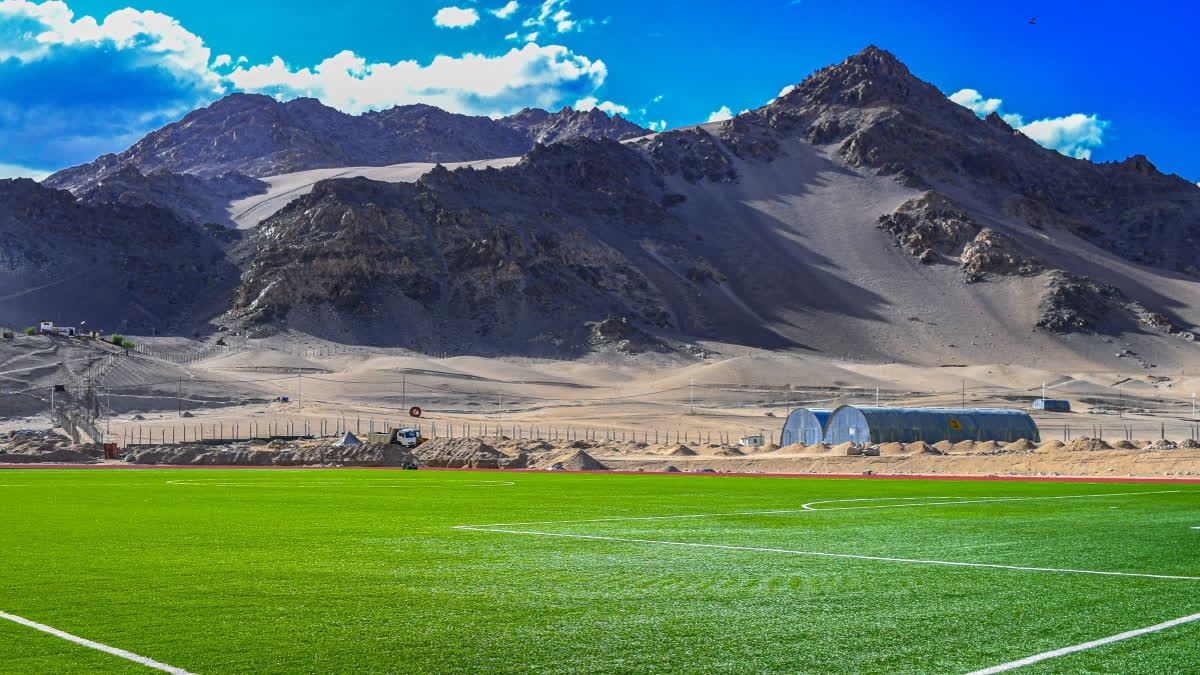The new astroturf open stadiums in Leh and Kargil are more than just patches of green; they are beacons of hope and opportunity for local athletes. Today, these stadiums are reshaping the sporting landscape, providing a platform for young talent to thrive. Two astroturf stadiums of international standards-one at Leh at an altitude of 11,500 feet and the second at Kargil, at an altitude of 9000 feet-are catering to athletes. The open stadium in Leh district has a seating capacity of 30,000 spectators and covers an area of 130 kanals. It features an internationally standard AstroTurf football field and an eight-lane synthetic track, making it suitable for various sports activities, including football and Olympic-style track events. Similarly, the astroturf stadium at Kargil was completed in 2023.
The international standard football turf stadium in Leh is believed to be the country’s highest sports stadium located at an altitude of about 11,500 feet above sea level.
For years, local athletes trained on uneven, rocky surfaces, often unable to pursue their passion due to inadequate facilities. The dream of having world-class sports infrastructure was realised when the government built astro-turf stadiums. Completed in 2022, these stadiums are equipped with modern amenities, enabling athletes to practice year-round, regardless of the weather.
Tsering Angmo, General Secretary of Ladakh Football Association, says, “This stadium is the highest in the world and it attracts sports tourism in Ladakh as well. Previously, only 50 per cent of students participated in football, but now about 70 per cent of 100 students are playing, thanks to the Astroturf facilities. Earlier, organising tournaments used to be challenging due to muddy grounds, which posed risks of injury, and physical education teachers would mark the fields with chalk, lacking proper facilities. We’re excited about upcoming developments, including the addition of physiotherapists, nutritionists, and more. The Astroturf stadium allows us to host national tournaments like the Climate Cup, and we receive numerous requests from clubs wanting to participate in Ladakh each year. Our players now have the opportunity to compete with major clubs at a professional level. Since 2019, we’ve sent 10 teams to national football competitions, enhancing our representation in sports and tourism, among other benefits.”
Transforming Lives
Meet Stanzin Tsepak, a 34-year-old, Senior Football Captain from Leh who remembers the days when his only training ground was a dusty field. Now, with the new stadium, players practice daily on a smooth, reliable surface, and their performance has significantly improved.
“Most grounds elsewhere are either natural grass or AstroTurf. In the past, we played on muddy fields with small pebbles, which caused the ball to change direction unpredictably, impacting both scoring and player performance. With this AstroTurf, the ball moves smoothly across the surface, allowing skilled players to excel. If the ground conditions are poor, even talented players struggle to showcase their abilities. The availability of AstroTurf benefits emerging players, while senior players have experienced the challenges of muddy fields. Over the next two to three years, we expect to see significant development in our budding players, leading to a strong team representing UT Ladakh.”
